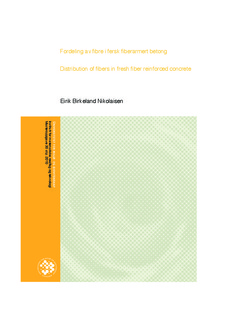Fordeling av fibre i fersk fiberarmert betong
Master thesis
Permanent lenke
http://hdl.handle.net/11250/188668Utgivelsesdato
2010-12-15Metadata
Vis full innførselSamlinger
- Master's theses (RealTek) [1722]
Sammendrag
This study examines the distribution of steel - and plastic fiber in fresh fiber reinforced concrete. This
is in relevance to, whether the use of fiber reinforced concrete in structural concrete is advantageous or
not.
The thesis is divided into the following two parts:
1. Literature study, focusing on the fiber reinforced concrete properties, fiber distribution in
concrete and previous field trials.
2. Field work at the site of construction, consisting of two series of experiments; quantitative
measurements of plastic fibers and steel fibers in fiber reinforced concrete. In order to
investigate whether variation occurs in the fiber distribution of the concrete batch as delivered
at the construction site, samples were taken from each concrete truck at three different time
intervals: at the start-, middle- and end of discharge.
Based on the experimental results in this study, the following conclusions may be drown:
• In steel fiber reinforced concrete with 25 kg fiber/m3, the deviation in fiber content from the
quantity specified increases towards the end of discharge.
• In plastic fiber reinforced concrete with 7 kg fiber/m3, the deviation in fiber content from the
quantity specified decreases towards the end of discharge.
• 33 % of the steel fiber samples from fiber reinforced concrete do not comply with the
suggested upcoming requirement of a minimum fiber content of 0,85 x fiber content specified
in individual samples, and a minimum 0,9 x fiber content specified in an experimental 3 tests
series per truck. Therefore, in cases where the fiber-reinforced concrete is specified in
structural concrete, it will, in accordance with the new guidelines for the use of fiber
reinforced concrete, be a requirement to introduce fibers to the batch during mixing at the
ready – mix plant, which also will ensure documentation of added fibers.
• Each one of the plastic fiber samples complied with the upcoming requirements.
• Fiber reinforced concrete used in conjunction with modern structurally integrated formwork
systems, like Cofraplus 77, seems to be a rational way to do concrete work, even though the
fibers only take care of the shrinking.
• Test methods used in this study to separate fiber from concrete, proved to serve their purpose.
The size of samples are larger than before, but not too big to handle.
